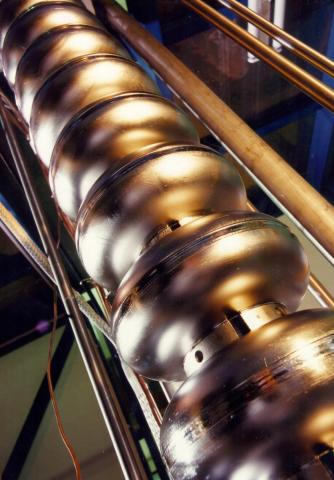

ARIEL hits another milestone on the way to the September 30 deadline. A major component of the ARIEL project is the electron linear accelerator, or e-linac. With the e-linac just recently installed in the E-Hall on-site, the teams have conducted various tests to ensure the installation was technically successful. On May 23, ARIEL received her Operating License from the Canadian Nuclear Safety Commission, allowing the e-linac to generate beams. The first stream of electrons was produced on June 1 in order to test the e-gun and other components within the e-linac, including one of the five superconducting radio-frequency (SRF) cavities.
The e-linac kicks off with an electron gun that is used to separate electrons from atoms and jolt the electrons down the beamline. Along the beamline will be five SRF cavities that accelerate the electrons to nearly light speed. Magnets will be used to steer and direct the electrons along the beamline to the Target Hall. There, the electrons impinge on a stopping material that converts their energy to photons. The photons bombard a target material creating the isotopes for science and medical research.
Designing and fabricating a superconducting radio-frequency cavity is no simple feat! The five SRF cavities for ARIEL –one of which is currently installed in the E-Hall–are being made in Canada by PAVAC Industries (Richmond B.C.) in collaboration with TRIUMF. The collaboration between TRIUMF and PAVAC began in 2004 and resulted in the first production of superconducting cavities in Canada. PAVAC is one of a handful of companies in the world capable of producing SRF cavities.
SRF cavities are a complex feat of physics and engineering. Electromagnetic radio-frequency fields produced inside the cavities accelerate the electrons. The fields are supported by oscillating electric currents on the walls of the cavity. The currents are subject to resistive losses that heat the walls of the cavity. In order to reduce the wall losses good electrical conducting materials are required. For example, a cavity made from copper operating at room temperature would dissipate 1 MW of RF power. This would be impossible to keep from overheating. Instead superconducting technology was chosen. In this case the RF surface resistance of the cavity surface is 100,000 times better than copper so that only 10W of RF power is dissipated.
The SRF cavities are fabricated from niobium and operate at 2 Kelvin (-271°C), 2 degrees above absolute zero. Absolute zero is the coldest possible temperature in the universe. The difficulty in producing the cavities comes in trying to keep the niobium pure during machining, welding and handling. Any foreign material imbedded near the surface will compromise its superconducting properties and render the cavity unusable. The successful collaboration between TRIUMF and PAVAC has mastered this challenging technology.
Using SRF technology for ARIEL gives TRIUMF and PAVAC Industries the experience necessary to participate in global discussions and projects, while training the next generation of leaders in this field.
By Kyla Shauer, Communications Assistant
